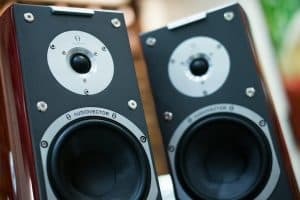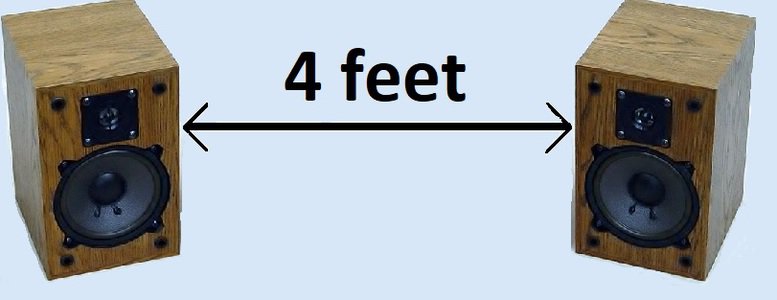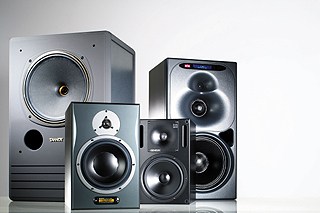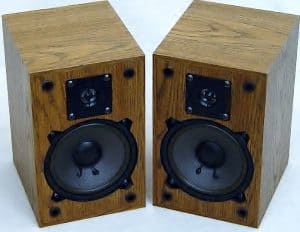Bookshelf speakers are for sound, but you can also use them for visuals by arranging them into more aesthetically pleasing patterns. For example, you can lay them on their sides. There are reasons that speakers are designed and built the way they are, but that doesn’t mean you have to stick to the rules.
If you are using bookshelf speakers for simple audio listening purposes, they can be placed on their sides. However, you need to consider some factors that may affect the sound quality, such as vertical dispersion, airflow, and stereo imaging. These factors will severely affect your speakers for production purposes, but you should be fine for simple listening pleasure.
Let’s consider bookshelf speaker placement in a room first because many individuals disregard this first critical step. Then, we will look at what how bookshelf speakers are affected if placed on their sides.
Let’s get started.

Keep track of all your music and notes in one convenient place!
Over 1000 sold to songwriters everywhere – with a 5-star rating.
Bookshelf Speaker Placement
Let’s discuss speaker placement in terms of acquiring proper sound and then we can determine what options you have when placing your bookshelf speakers and determine if we can, in fact, place them on their side.

The first thing you have to understand is that location and placement is by far the most critical factor you have to consider when placing your speakers. No matter if they are bookshelf speakers, studio monitors, or speakers from your home theater system.
You want to start by roughly placing your speakers in the shape of an equilateral triangle in relation to your listening position. Keep in mind that bookshelf speakers are designed to be medium-field speakers in most cases.
Note: “medium-field” means that the speakers are designed for the best listening experience when they are situated approximately 5 feet away from you.
However, depending on the brand and model of speaker, you can get ones that are designed to be near-field or even far-field bookshelf speakers. The same is true for studio monitors, but for practical purposes, studio monitors are usually designed to be near-field monitors.
The distance between your bookshelf speakers should be approximately 4 feet. This is due to the size and power that the speakers exert. Further separation might cause too much loss in the audio signal causing a poor listening experience.

The speaker’s tweeters should be in line with your ears. This is where you really need to consider whether you should place bookshelf speakers on their side (we will discuss this more under the next heading below).
After you have placed your bookshelf speakers approximately 4 feet away from each other in an equilateral triangle shape and the tweeters inline with your ears (remember to take into consideration being seated or standing), you need to adjust the speaker angle.
This means the speakers should be pointed slightly inward towards each other and the listener. this will help create a centered audio field and a more pleasant listening experience.
Other Factors To Consider When Placing Bookshelf Speakers
Bookshelf speakers are designed to be small to medium in size so they will fit on a bookshelf. In some cases, you can’t exactly place the speakers as we suggested above.
If you need to put them on a shelf, consider placing them as far apart as possible, still trying to keep the tweeters in line with your ears. This offers you the best possible listening experience.
One thing to note is that speakers should always be placed approximately 2 to 3 feet away from the wall if possible due to frequencies (especially bass frequencies) getting trapped and bouncing off the wall, causing a delay and reverberation effects.
In the case of bookshelf speakers, this is sometimes unavoidable but these types of speakers are usually suited for easy listening pleasure and not for studio applications, so you probably won’t notice anything.
If you do notice a problem in the audio sound and you are using these speakers for production purposes, then this is a problem for you, and you should not be considering bookshelf speakers in the first place but rather studio monitors.

Check out my review on the best studio monitors your money can buy on a budget (or with as much money as you have to spend).
The last aspect we will cover when trying to place and arrange your bookshelf speakers is considering other materials and objects in your room. You would have no objects in the room in a perfect world except perhaps sound diffusers and absorbers to get the best possible frequency response from the room.
Make sure that there is nothing obstructing the audio signal from the speakers to your listening position. This will surely impact and affect what you hear.

Placing Bookshelf Speakers On Horizontally (On Their Sides)
Now that we have figured out how our bookshelf speakers should be placed in terms of positioning in a room, we can cover whether or not they can be placed on their sides.
For the most part, you can place bookshelf speakers on their sides, and you can actually place studio monitors on their sides if you are considering that. However, this is not optimal because speakers are designed a specific way.
The four main factors that will be affected when you place a bookshelf speaker on its side are;
- Bass driver positioning
- Airflow
- Vertical dispersion
- Stereo imaging
When the bass driver (woofer) is misaligned and the driver is placed on its side, it has support coming from a different angle. This could affect the bass response and thus the overall frequency response of the bass driver.
Considering the airflow and where the holes are situated on your bookshelf speakers, placing them on their sides could also be problematic. This is especially true if your bookshelf speakers are active and have built-in amplifiers.
Amplifiers draw electricity and thus create heat. Without proper ventilation, they will surely overheat and get damaged. If you place your bookshelf speakers on their sides, make sure they are not covering any ventilation holes.
Some people say that vertical dispersion will be affected when you place bookshelf speakers on their sides. This is partially true depending on how you place them regarding other objects in the room. If you have placed them correctly, then the reflection they cause won’t be that much of an issue or at all.
Furthermore, remember that you are not using them for recording or production purposes, so this factor can be ignored to a degree. Just remember that the tweeter’s waveguide controls speaker dispersion. If you are looking for quality audio sound, then you should consider this aspect of a tweeter and place the speakers vertically.
The last factor that you could also possibly ignore is stereo imaging. Placing the speakers on their sides will affect the stereo imaging to a degree, especially if the tweeters are not lined up with your ears. If they are aligned to your ears and positioned according to our first section, this shouldn’t be a problem because bookshelf speakers should only be used for listening pleasure and not production.
Placing bookshelf speakers on their side could inevitably lead to a comb filtering effect, phase cancellation of sorts, and an incorrect stereo sound profile. Covering these aspects is beyond the scope of this article, but you should be aware of them if you are an avid audiophile or music producer and you require perfection.
Conclusion
We discovered that although you can place bookshelf speakers on their sides, you are probably better off if you don’t. Although you may not damage them (unless they are active speakers and the amplifiers inside overheat due to bad air circulation), the sound quality may be affected depending on various factors that we covered (such as placement and objects in a room).
If you are using your bookshelf speakers for the simple audio listening pleasure and not for music production of any sorts, then you are able to place them on their sides without fear of anything going wrong or the sound quality getting affected to the degree that you can actually hear it.
Read these articles to learn about using bookshelf speakers as a center channel or as studio monitors.
Learn the difference between bookshelf speakers and soundbars here.
You can learn about 2-way vs 3-way speakers here.
Source list
Bookshelf speakers … placing them on their sides?
can you mount a bookshelf speaker on its side?
